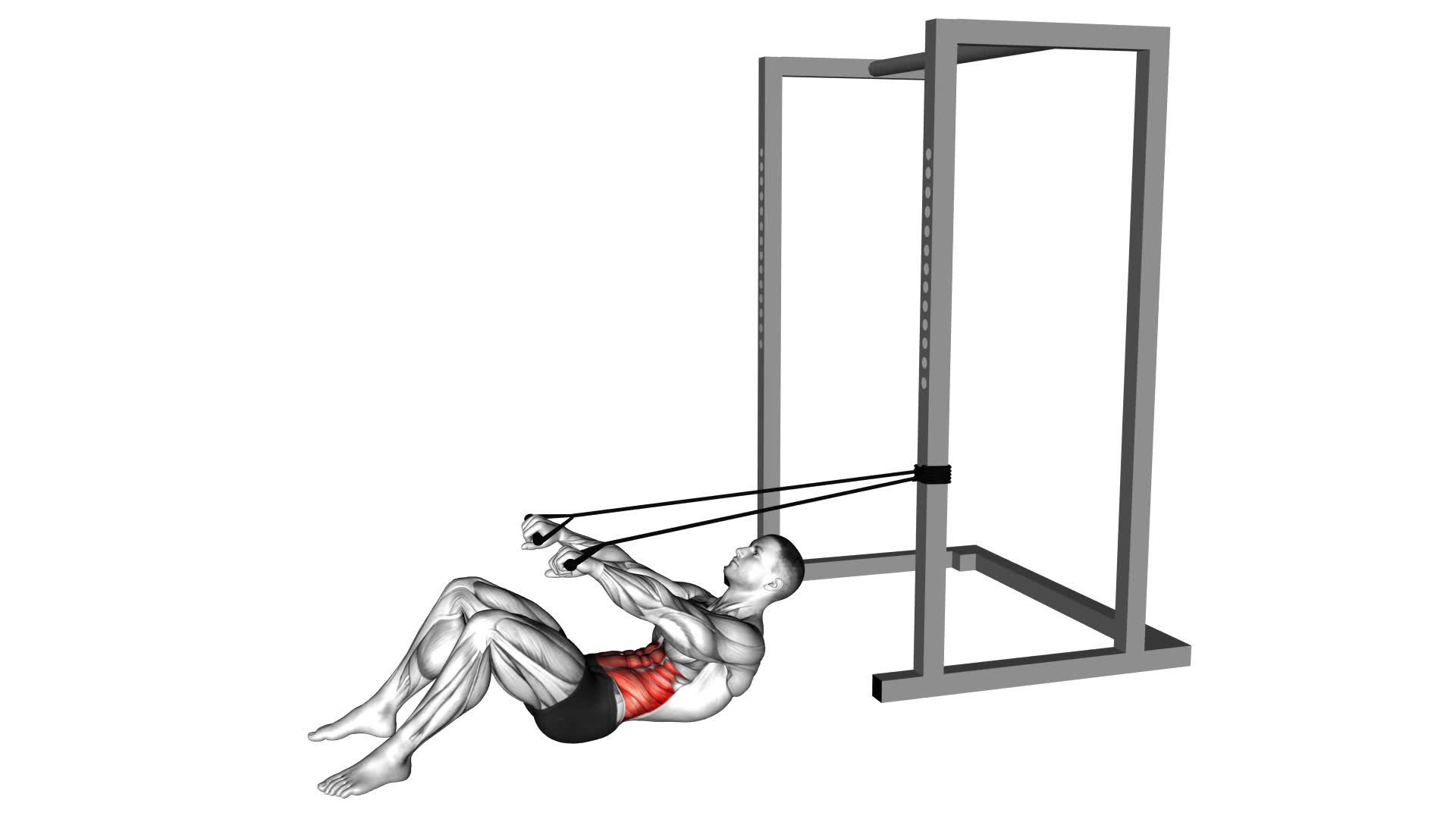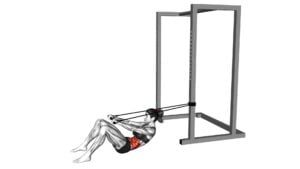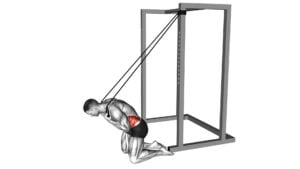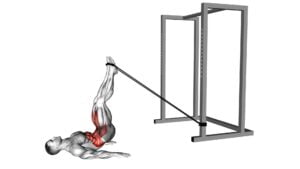Band Upper Crunch (male) – Video Exercise Guide & Tips

Are you looking for a challenging ab exercise that targets your upper core? Look no further than the Band Upper Crunch.
Watch This Exercise Video
This video exercise guide will show you the proper form and technique to maximize your results.
With just a resistance band and a few minutes of your time, you can strengthen and tone your abs like never before.
Get ready to feel the burn and see the results with the Band Upper Crunch.
Key Takeaways
- The Band Upper Crunch is highly effective in improving posture.
- It strengthens abdominal muscles and enhances core stability.
- The exercise targets the rectus abdominis for toned abs.
- It engages the oblique muscles for overall muscular development.
Benefits of the Band Upper Crunch
You should regularly perform the Band Upper Crunch exercise to maximize its benefits. This exercise is highly effective in improving posture and strengthening your abdominal muscles. By incorporating the Band Upper Crunch into your regular workout routine, you can achieve a stronger core and better overall stability.
One of the main benefits of the Band Upper Crunch is the improvement it brings to your posture. As you engage your abdominal muscles and lift your upper body off the ground, you're actively working to strengthen the muscles that support your spine. This helps to maintain a more upright posture and reduces the risk of developing poor posture habits.
Additionally, the Band Upper Crunch targets your abdominal muscles, providing a challenging workout for your core. This exercise specifically targets the rectus abdominis, the muscle responsible for creating those coveted six-pack abs. By consistently performing the Band Upper Crunch, you can strengthen your abdominal muscles, leading to improved stability and a more toned midsection.
Incorporating the Band Upper Crunch into your routine also has the added benefit of engaging your obliques, the muscles on the sides of your abdomen. This helps to further strengthen your core and enhance your overall muscular development.
Now that you understand the benefits of the Band Upper Crunch, it's important to learn the proper form and technique for performing this exercise.
Proper Form and Technique for the Band Upper Crunch
To perform the Band Upper Crunch with proper form and technique, there are a few key points to keep in mind.
First, focus on engaging your core muscles throughout the exercise to maximize effectiveness.
Secondly, ensure that the resistance band is securely placed around your upper back and shoulders, providing the necessary tension.
Lastly, remember to breathe consistently and exhale on the contraction phase of the movement to maintain control and stability.
Core Engagement Tips
For proper form and technique in performing the Band Upper Crunch exercise, focus on engaging your core muscles. Here are some tips to help you maximize core stability and strengthen your core:
- Lie flat on your back with your knees bent and feet flat on the ground.
- Place the resistance band around your upper thighs, just above the knees.
- Keep your hands behind your head, with your elbows pointing out to the sides.
- As you lift your upper body off the ground, focus on contracting your abdominal muscles and exhale.
By engaging your core muscles throughout the exercise, you won't only improve your form but also enhance the effectiveness of the Band Upper Crunch.
Now, let's move on to the next section and discuss the proper placement of the resistance band.
Resistance Band Placement
To properly execute the Band Upper Crunch exercise, focus on the placement of the resistance band around your upper thighs. This is a crucial step in maximizing the effectiveness of the exercise and targeting your abdominal muscles.
Start by lying on your back with your knees bent and feet flat on the floor. Place the resistance band around your thighs, just above your knees, ensuring it's secure and not too tight.
The resistance band adds an extra challenge to the exercise by engaging your hip muscles and increasing resistance throughout the movement. This targeted resistance helps to strengthen your core and improve abdominal strength.
Breathing During Exercise
Maintain controlled and rhythmic breathing throughout the Band Upper Crunch exercise to enhance your performance and maximize the benefits. Proper breathing techniques can greatly improve your workout experience and overall results.
Here are four key benefits of proper breathing during the Band Upper Crunch:
- Oxygenation: Deep and controlled breaths ensure an adequate supply of oxygen to your muscles, increasing endurance and reducing fatigue.
- Core Activation: Proper breathing engages your deep core muscles, promoting stability and enhancing the effectiveness of the exercise.
- Mind-Body Connection: Focusing on your breath helps you stay present and connected to your body, improving coordination and concentration.
- Stress Reduction: Deep breathing triggers the relaxation response, reducing stress levels and promoting a sense of calm during your workout.
Equipment Needed for the Band Upper Crunch
You will need a band's resistance for the Band Upper Crunch exercise. This equipment is essential to provide the necessary resistance and challenge for your core muscles during the workout. The band's resistance helps to engage and strengthen your core stability, making the exercise more effective in targeting your abdominal muscles.
When choosing a band for the Band Upper Crunch, it's important to select one with an appropriate level of resistance. The band should provide enough tension to challenge your muscles, but not so much that it becomes difficult to maintain proper form and technique. Start with a band that offers a moderate level of resistance and adjust as needed to suit your fitness level and goals.
If you don't have access to a band, there are alternative exercises that you can do to target your upper abs. Some effective alternatives include traditional crunches, bicycle crunches, and reverse crunches. These exercises can be done without any equipment and still provide a challenging workout for your abdominal muscles.
Remember to always listen to your body and choose the equipment and exercises that are suitable for your fitness level. It's important to maintain proper form and technique to prevent injury and maximize the benefits of your workout.
Modifications and Variations for the Band Upper Crunch
To add variety to your Band Upper Crunch routine, occasionally incorporate different modifications and variations to keep your workout engaging and challenging. Here are four modifications and variations you can try:
- Single Arm Band Upper Crunch: Instead of using both arms to perform the upper crunch, focus on one arm at a time. This variation will challenge your core stability and engage your oblique muscles more effectively.
- Band Reverse Upper Crunch: Start by lying on your back with your legs extended straight up in the air. Place the band around your feet and hold the handles with your hands. Instead of crunching upward, lift your hips off the ground, bringing your legs towards your chest. This variation targets your lower abs and hip flexors.
- Band Twist Upper Crunch: Begin by lying on your back with your legs bent and feet flat on the ground. Hold the band handles with your hands and place the band across your chest. As you perform the upper crunch, twist your torso to one side, engaging your oblique muscles. Alternate sides with each repetition.
- Band Russian Twist: Sit on the ground with your knees bent and feet flat. Hold the band handles with your hands and extend your arms straight in front of you. Lean back slightly, engaging your core. Twist your torso to one side, bringing the band towards that side. Return to the starting position and repeat on the other side. This exercise targets your obliques and improves rotational strength.
Incorporating these modifications and variations into your Band Upper Crunch routine won't only keep your workout interesting but also challenge different muscle groups for a more well-rounded core workout.
Common Mistakes to Avoid During the Band Upper Crunch
To maximize the effectiveness of your Band Upper Crunch, it's important to regularly assess and correct any common mistakes that may hinder your progress. One of the most common mistakes people make during this exercise isn't engaging their core properly. It's crucial to maintain a strong core throughout the movement to target the desired muscles effectively.
One mistake to avoid is relying solely on your neck and shoulders to lift your upper body. Instead, focus on using your abdominal muscles to initiate the movement. This will prevent strain on your neck and shoulders and ensure that your core is doing the work.
Another common mistake isn't keeping your lower back firmly pressed against the ground. This can lead to excessive arching of the back and take away from the effectiveness of the exercise. Make sure to engage your core and keep your lower back flat on the floor throughout the movement.
Lastly, avoid using momentum to perform the Band Upper Crunch. It's important to control the movement and work your muscles through the full range of motion. Using momentum can reduce the effectiveness of the exercise and increase the risk of injury.
Tips for Maximizing the Effectiveness of the Band Upper Crunch
To maximize the effectiveness of the Band Upper Crunch, it's important to focus on proper form techniques.
Make sure to engage your core muscles throughout the exercise and avoid using momentum to lift your upper body.
Additionally, gradually increasing the resistance of the band will help challenge your muscles and promote growth.
Proper Form Techniques
Maximize the effectiveness of your Band Upper Crunch by focusing on proper form techniques. Follow these tips to ensure you're targeting your core muscles with precision and maximizing your workout:
- Maintain core stability: Engage your core throughout the exercise by pulling your belly button towards your spine. This will help stabilize your body and prevent unnecessary strain on your back.
- Proper alignment: Position yourself with your back flat on the floor and your knees bent. Keep your feet firmly planted on the ground and your hands supporting your head, avoiding pulling on your neck.
- Controlled movements: Slowly lift your upper body off the ground using your abdominal muscles, rather than relying on momentum. Avoid using your neck or arms to lift yourself.
- Full range of motion: Aim to bring your shoulder blades off the ground while keeping your lower back pressed into the floor. This will ensure that you're engaging your entire core and maximizing the effectiveness of the exercise.
By following these proper form techniques, you can effectively target your core muscles and achieve the best results from your Band Upper Crunch.
Let's now move on to the next section, where we'll discuss targeting core muscles in more detail.
Targeting Core Muscles
By targeting your core muscles, you can optimize the effectiveness of the Band Upper Crunch exercise. Core stability is essential for maintaining proper form and preventing injury during this exercise. To engage your core muscles, start by lying on your back with your knees bent and your feet flat on the ground. Place the resistance band around your upper back and hold the ends with your hands.
As you crunch up, focus on contracting your abdominal muscles and pulling your belly button towards your spine. This will help to strengthen your abdominal muscles and improve overall core stability. Remember to exhale as you crunch up and inhale as you lower back down.
Gradually Increasing Resistance
To increase the effectiveness of the Band Upper Crunch exercise, gradually increase the resistance of the band. By increasing the difficulty level of the exercise, you can challenge your core muscles even more and achieve better results.
Here are four tips for maximizing the effectiveness of the Band Upper Crunch:
- Start with a light resistance band and gradually progress to a heavier one as your strength improves. This will help you build endurance and prevent plateauing.
- Perform the exercise with controlled and slow movements, focusing on engaging your core throughout the entire range of motion. This will ensure that you're targeting the right muscles and getting the most out of each rep.
- Incorporate variations into your routine, such as adding a twist or holding the crunch at the top position. This will increase the intensity and engage different parts of your core.
- Don't forget to maintain proper form and alignment during the exercise. Keep your back flat against the floor and avoid straining your neck or shoulders.
Frequently Asked Questions
How Many Sets and Reps Should I Do for the Band Upper Crunch?
To maximize the benefits of the band upper crunch, it's important to consider the number of sets and reps. Without knowing the specific context of the video exercise guide, it's difficult to provide an exact answer.
However, for most exercises, it's recommended to start with 2-3 sets of 10-15 reps. As you progress and become more comfortable, you can increase the number of sets or reps, or even try different variations of the band upper crunch to challenge your muscles further.
Can I Do the Band Upper Crunch if I Have a Lower Back Injury?
If you have a lower back injury, it's important to be cautious with exercises that put strain on that area.
The Band Upper Crunch may not be suitable for you in this case.
It's best to consult with a medical professional or a physical therapist who can recommend modifications or alternative core exercises that are more suitable for your condition.
Prioritizing safety and proper form is crucial to prevent further injury and promote healing.
Is It Necessary to Use a Resistance Band for the Band Upper Crunch, or Can I Use Other Equipment?
You don't necessarily need a resistance band for the band upper crunch. There are alternative equipment options you can use, like dumbbells or a cable machine. These can provide a similar level of resistance for the exercise.
However, if you have a lower back injury, it's important to modify the band upper crunch to avoid aggravating your condition. Consult with a fitness professional to learn proper modifications and ensure your safety while performing this exercise.
Can I Do the Band Upper Crunch if I'm a Beginner or Have Limited Core Strength?
If you're a beginner or have limited core strength, the band upper crunch can still be done with modifications. Start by using a lighter resistance band or even a towel. Focus on engaging your core muscles and taking it slow.
If the band upper crunch feels too challenging, there are alternative core exercises you can try, such as planks, Russian twists, or seated knee tucks. Remember to listen to your body and gradually increase the intensity as you build strength.
How Does the Band Upper Crunch Compare to Traditional Crunches in Terms of Effectiveness?
The band upper crunch is a great alternative to traditional crunches. It targets your upper abs and adds resistance due to the band. This makes it more effective in building strength and definition in your core.
Using a resistance band for the band upper crunch provides additional benefits such as increased muscle activation and improved stability.
Conclusion
In conclusion, the Band Upper Crunch is a highly effective exercise for targeting and strengthening the upper abdominal muscles.
By using a resistance band, you can increase the intensity and challenge of the exercise.
Remember to maintain proper form and technique to maximize the benefits and avoid common mistakes.
With regular practice and proper modifications, the Band Upper Crunch can help you achieve a stronger and more defined core.

Author
Years ago, the spark of my life’s passion ignited in my mind the moment I stepped into the local gym for the first time. The inaugural bead of perspiration, the initial endeavor, the very first surge of endorphins, and a sense of pride that washed over me post-workout marked the beginning of my deep-seated interest in strength sports, fitness, and sports nutrition. This very curiosity blossomed rapidly into a profound fascination, propelling me to earn a Master’s degree in Physical Education from the Academy of Physical Education in Krakow, followed by a Sports Manager diploma from the Jagiellonian University. My journey of growth led me to gain more specialized qualifications, such as being a certified personal trainer with a focus on sports dietetics, a lifeguard, and an instructor for wellness and corrective gymnastics. Theoretical knowledge paired seamlessly with practical experience, reinforcing my belief that the transformation of individuals under my guidance was also a reflection of my personal growth. This belief holds true even today. Each day, I strive to push the boundaries and explore new realms. These realms gently elevate me to greater heights. The unique combination of passion for my field and the continuous quest for growth fuels my drive to break new ground.







